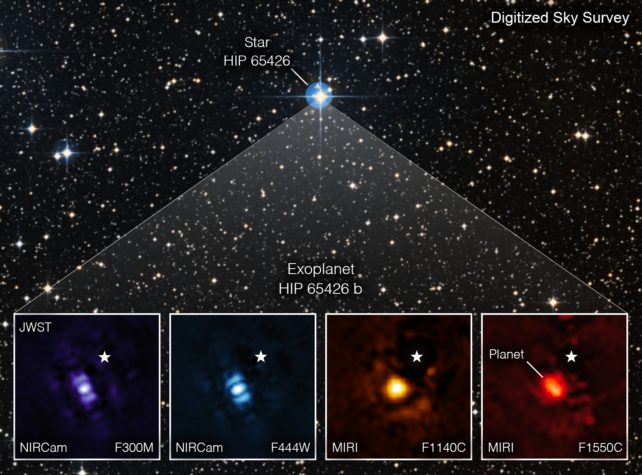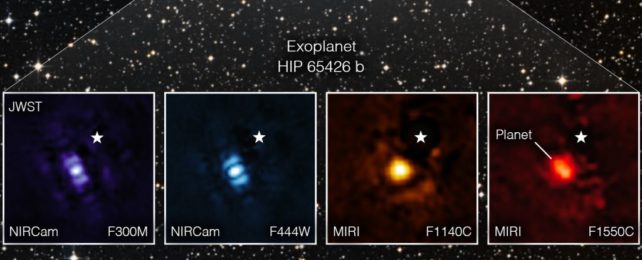The James Webb Space Telescope has just delivered its first direct image of a planet orbiting a distant star.
The gas giant's faint glow was captured near a young star around 350 light-years away, serving as a demonstration of the telescope's abilities to directly observe exoplanets – a technically difficult task, but one that gives us a different tool for the study of alien worlds to the indirect methods most commonly used.
"This is a transformative moment," says physicist and astronomer Sasha Hinkley of the University of Exeter in the UK, "not only for Webb but also for astronomy generally."
To date, more than 5,000 planets orbiting stars in the Milky Way galaxy outside the Solar System have been officially observed. Of these exoplanets, most have only been observed indirectly, through the effects they have on their host star.
When an exoplanet passes between us and its host star, the light of the star dims, just a little; if we detect these dimming events at regular intervals, we can infer the presence of an orbiting exoplanet.
Likewise, an exoplanet's presence will exert a miniscule gravitational pull on its star, which we can detect as regular changes in the starlight's wavelength. Both of these techniques work best for exoplanets that are very close to their star.
It's very rare that we observe an exoplanet directly; only around 20 have been imaged in high contrast to date. Exoplanets are very far away from our instruments, very small, and very dim, especially compared to the light shining from their host star.

An exoplanet can be many magnitudes dimmer than the halo of light diffracting from the star they orbit; yet it's the best tool we have for characterizing exoplanets that orbit their stars at wide separations, with very long multi-year orbits.
Exoplanet scientists have high hopes pinned to JWST, with its high sensitivity. And now it seems those hopes are well founded.
The exoplanet imaged by the telescope is called HIP 65426 b, orbiting an A-type main sequence star called HIP 65426 or HD 116434, at a distance around 110 astronomical units – 110 times the distance between Earth and the Sun.
It was discovered in 2017, using an instrument on the European Southern Observatory's Very Large Telescope called SPHERE. Equipped with an attachment called a coronagraph, it minimizes light from the star to see the exoplanet's shine.
In the near-infrared wavelengths detected by the VLT, the exoplanet is about 10,000 times fainter than the star.
Because it is in space and is not therefore affected by atmospheric interference, and can view longer infrared wavelengths than the VLT, JWST's observations have been able to reveal new details about the exoplanet.
For example, they allowed the researcher to determine that HIP 65426 b is about 7.1 times the mass of Jupiter. It's therefore probably a gas giant, so unlikely to be habitable to life as we know it.
Even at the mid-infrared wavelengths observed by JWST's MIRI instrument, the detection was a challenging one, with the exoplanet still coming in at a few thousand times fainter than the star.
Nevertheless, JWST was able to detect HIP 65426 b in all seven of its observational filters, and achieved the first direct detection of an exoplanet at wavelengths longer than 5 micrometers.
"Obtaining this image felt like digging for space treasure," says astronomer Aarynn Carter of the University of California, Santa Cruz. "At first all I could see was light from the star, but with careful image processing I was able to remove that light and uncover the planet."
The telescope, the team says, exceeded its expected contrast performance by a factor of 10 – extremely important for high-contrast direct exoplanet imaging. At the contrast performance achieved, the team expects that the telescope will be able to see exoplanets as small as a third of the mass of Jupiter, beyond orbital separations of 100 astronomical units.
"I think what's most exciting is that we've only just begun," Carter says. "There are many more images of exoplanets to come that will shape our overall understanding of their physics, chemistry, and formation. We may even discover previously unknown planets, too."
The team's research has been submitted to preprint server arXiv, and has been submitted for peer review.
